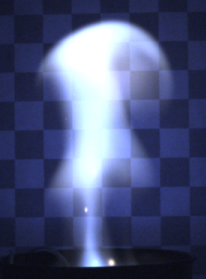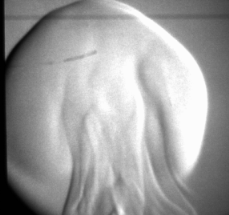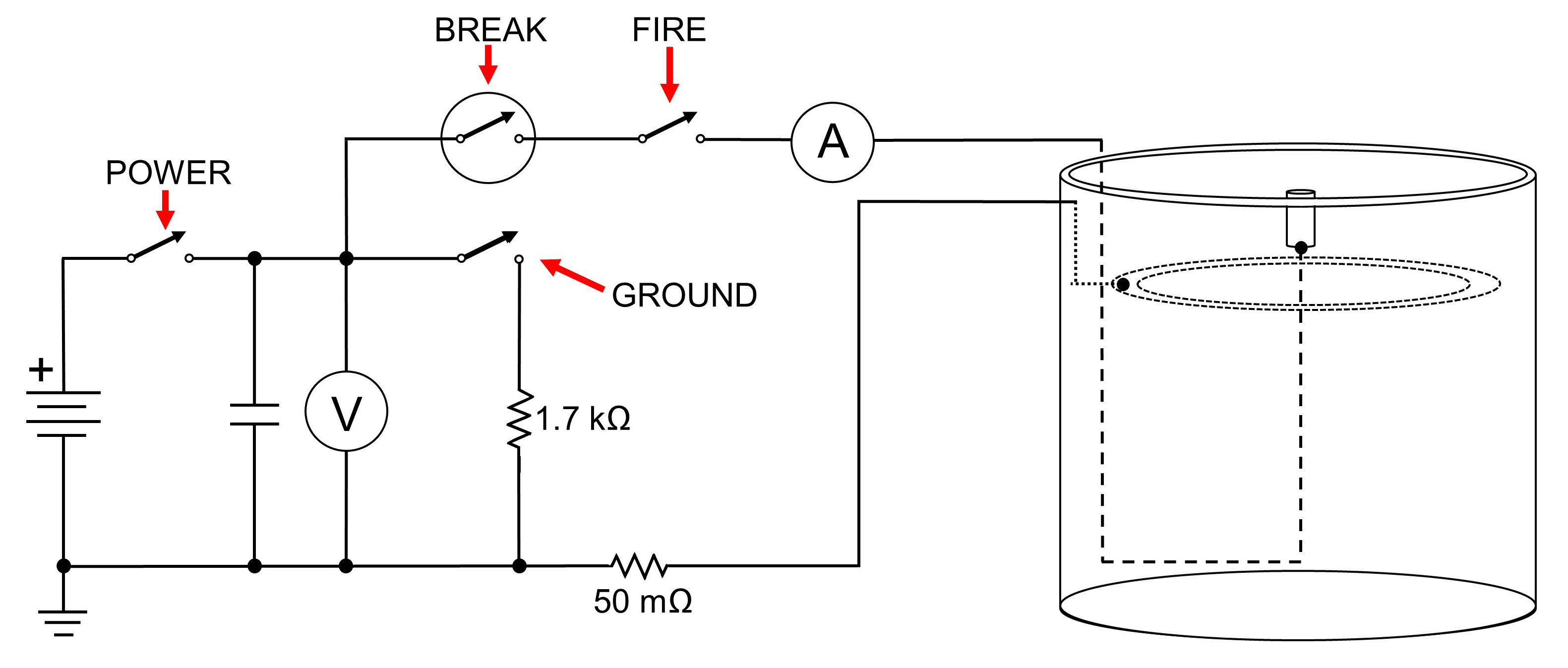Ball Plasmas

A picture of a typical ball plasmoid before detaching from the electrode. Background is a 5 cm grid.
Introduction
Ball Lightning is a naturally occurring but poorly understood phenomenon. People from all over the world have reported seeing luminous balls dancing through the sky both in and around thunderstorms. According to these eyewitness testimonies, these spheres of light vary in size from 1-100 cm, in lifetime from a few seconds to tens of seconds, and show interesting patterns of movement. What is perhaps most interesting about ball lightning is this long lifetime; plasmas similar to ball lightning should not last for more than a few milliseconds at atmospheric pressure. While many scientists have proposed theories to explain their physical nature, there is no current theory or set of theories that have fully explained the formation and behavior of ball lightning.
However, in 2002, two Russian scientists (Egorov A. and Stepanov S., Tech. Phys. 2002, 47, 1584-1586) developed a technique for producing water-based ball plasmoids, which are considered to be laboratory analogues of natural ball lightning. These plasmoids have been studied and characterized by a few research groups around the world, including ours. However, our collective understanding as to why and how these plasmas are so stable is still incomplete. We are studying these plasmoids from chemical and plasma physics perspectives with the hopes of elucidating the fundamental processes occurring within this plasmoid, which will address the gaps in the current understanding of ambient plasma recombination. Furthermore, our experiments could provide insight into the mystery of ball lightning.
Plasmoid Generator
To produce ball plasmoids, we utilize a high-voltage capacitive discharge which is struck over a grounded electrolyte. Several kiloJoules of energy are stored in a bank of capacitors (1958 μF max capacitance) which are charged up to 10 kV (DC). This energy is then "dumped" across a custom electrode setup which is partially submerged in a weak electrolyte. When the discharge is struck and a plasma begins to form, current begins to flow and eventually reaches a maximum (up to 128 Amps have been observed with this system). This produces a mushroom cloud-like plasma that increases in size, rises up and away from the electrode, and finally detaches. In this last phase of the discharge, a distinct plasmoid can be seen to exist independent of the electrodes.

A schlieren image of a plasmoid, highlighting the density gradient between atmosphere and the plasma.
Previous Studies
Many studies of the discharge electronics and plasmoid generator have been previously undertaken to better understand the mechanics of the discharge and to optimize the lifetime of the plasmoid. The plasmoid generator’s parameters (capacitance, voltage, electrode material), electrolyte parameters (conductivity, salt used, pH, temperature), and atmospheric / environmental parameters (humidity, gas temperature, gas used) have been investigated to various degrees (Friday et. al, J. Phys. Chem. A., 2013, 117(39), 9931-9940). We are making strides to improve the reproducibility and durability of the discharge electronics and circuitry while we work to further our understanding of plasmoids.
Additionally, in order to attempt to understand the physical processes that are occurring within the plasmoid, several groups have measured the properties of these plasmoids using spectroscopic techniques. These methods have included high and medium resolution emission spectroscopy in the ultraviolet and visible (Versteegh et. al, Plas. Sour. Sci. Technol., 2008, 17(2), 024014), and low resolution absorption spectroscopy in the infrared (Friday et. al). Videography (high speed visible, IR, and schlieren), probe diagnostic techniques (thermocouple and electric), photodiodes, and other indirect measurements have also been performed on this system by these two groups. Despite these studies, it is still unclear as to why these plasmoids have a lifetime that is so much longer than what current models predict.
| An average plasmoid (4 kV, .86 mF) at 10% live speed. | Our most vivid plasmoid with clear separation (6 kV, .86 mF) at 10% speed. | The interaction of a KimWipeTM with a plasmoid (7 kV, .86 mF) at 10% speed. |
Ball Plasmoids in the McCall Group
In order to identify the charge carriers present in the plasmoid, we have performed high-performance ambient mass spectrometry analysis on the discharge (Dubowsky et. al, Int. J. Mass Spectrom., 2015, 376, 39-45). Using a commercial instrument with a custom sampling interface, we were able to sample ions from the interior of the plasmoid. We observed ions that are commonly found in ambient plasmas, including protonated water clusters, nitrogen species, and others. More importantly, we were able to show (via a deuterium substitution experiment) that plasmoid composition is significantly affected by the composition of the electrolyte.
Furthermore, we have performed emission spectroscopy of the discharge in the mid-infrared (1000-5000 cm-1) in an effort to extend the spectroscopic knowledge of ball plasmoids (Dubowsky et. al, J. Mol. Spec., 2016, submitted). We have observed emission from water and hydroxyl radical from ball plasmoids and have extracted rotational temperatures for these molecules, data which begin to show the energy distribution of molecules within the plasmoid.
Future Work
Although we have made some progress toward an understanding of ball plasmoids, the remarkably long lifetime of these discharges (and by extension, ball lightning) remains a mystery. Ambient plasma recombination is an active field of research in plasma chemistry and physics, and we hope to contribute to the understanding of these phenomena in the future. Currently, we are working to apply cutting-edge spectroscopic diagnostic techniques to ball plasmoids; these techniques will provide unprecedented time resolution for this system and will also facilitate in situ measurements of the plasmoid, which will allow us to probe different regions of the plasmoid simultaneously.
Click here to listen to Dr. Mike Lindsay, Ben McCall’s former colleague and David Friday’s former research advisor, as he explains to the BBC what we know about ball lightning, how it's related to this project, and the potential applications of this research. This work was also featured in a BBC Science & Environment article, which can be found here.

